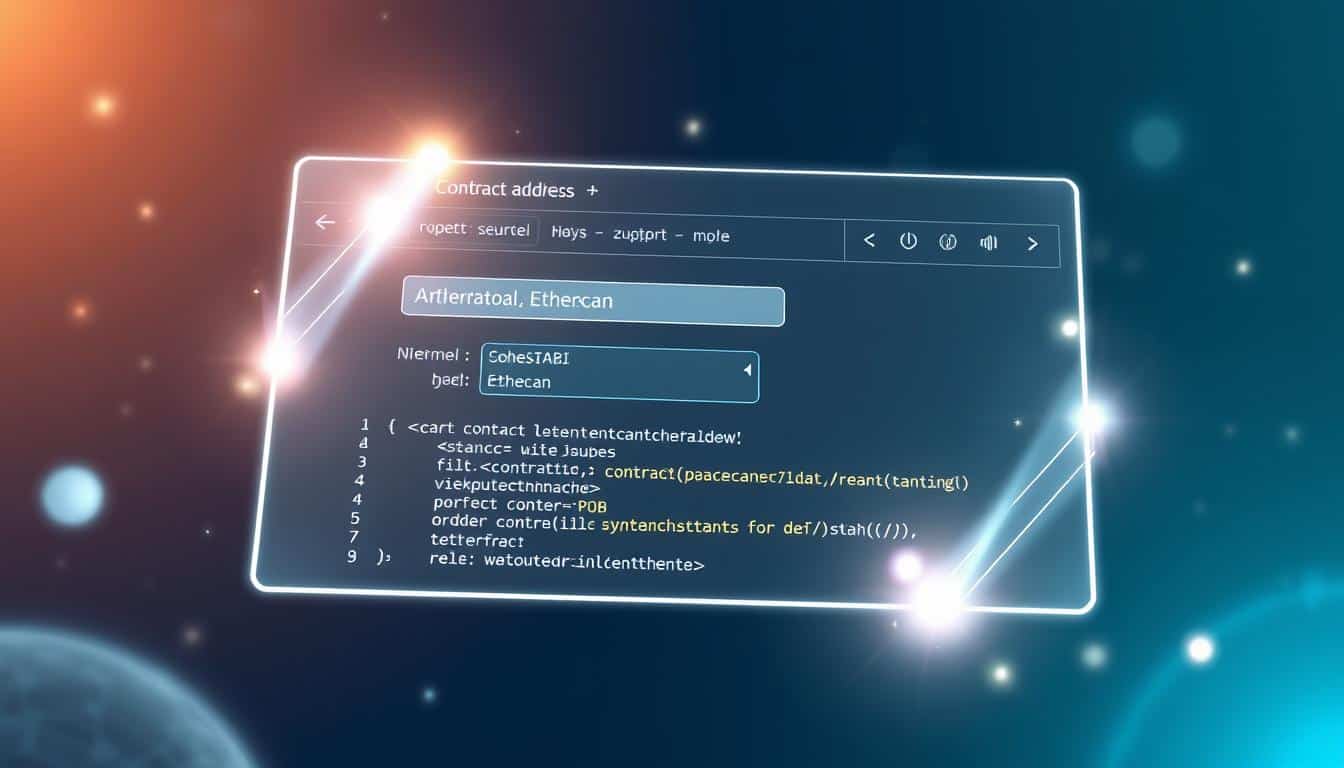Almost 40% of Ethereum contracts deployed are not verified on public explorers. This is surprising since so much money moves through these addresses daily. The gap has caused confusion, delays in audits, and unnecessary distrust among users. So, I decided verifying Ethereum smart contracts should always be part of deploying them.
This guide will teach you how to verify a smart contract on Etherscan. I’ll use tools like Hardhat, Truffle, Foundry, and Remix. Plus, I’ll dive into Etherscan’s verification UI and API. I’ll mention community plugins like hardhat-verify and truffle-plugin-verify. This way, you don’t have to start from scratch.
Verifying your smart contract on Etherscan is crucial. It doesn’t just keep you busy. It makes your code open for auditing, raises user trust, and helps show accurate data on-chain. We’ll look into the tools, verification steps, common mistakes, compiler advice, statistics, and examples. This will make you more confident in verifying Ethereum smart contract deployments.
Key Takeaways
- Verifying contracts boosts transparency and trust among users and auditors.
- I’ll discuss practical tools: Hardhat, Truffle, Foundry, Remix, and Etherscan’s UI/API.
- Community plugins simplify the process: hardhat-verify, truffle-plugin-verify, forge-verify-contract, remix-etherscan-plugin.
- Etherscan and market data provide important contract activity insights.
- The guide includes steps for verification, error solving, and choosing compilers.
Introduction to Smart Contracts
I began with a basic idea: making agreements work without needing middlemen. Ethereum’s smart contracts bring this idea to life. They automatically follow rules and manage everything from token swapping to DeFi operations, NFTs, and decisions made on the blockchain. My usual process involves compiling, deploying, and then interacting with these contracts. I’ll explain the importance of verification and the role of Etherscan in this process.
What Are Smart Contracts?
Smart contracts are programs that run by themselves. They’re written in Solidity and live on the Ethereum network. There are common types like ERC-20 for exchangeable tokens and ERC-721 for unique digital assets, or NFTs. DeFi projects usually have more complicated contracts with many parts and rules. I’ve worked with basic ERC-20 tokens and complex DeFi ones. The steps are: write the contract, compile it, put it on the blockchain, and then use it from a digital wallet or app.
Importance of Verification
Verifying source code connects the readable Solidity code and its settings to the final code on the blockchain. This helps users and reviewers check that a contract does what it’s supposed to. I once found a token without verified code and stayed away until its source was confirmed. Verifying increases trust, security, and helps with careful checking.
Overview of Etherscan
Etherscan is essential for exploring Ethereum’s blockchain. It displays transaction histories, contract code, and how contracts are built. When a contract’s source code has been verified, Etherscan offers an interface for anyone to interact with it directly. Researchers and the Ethereum community use Etherscan to analyze and review contracts. This piece includes a handy guide on using Etherscan for contract verification and tips for when you’re ready to share your code.
Why Verify Smart Contracts?
I’ve seen projects succeed or fail based on one decision: to publish their code or not. Verification on Etherscan makes the code readable and shows compiler settings. This allows developers, auditors, and curious users to examine the project’s details without having to guess.
Enhancing Transparency
The Etherscan verification process shows the source code next to the bytecode. This allows you to compare the actual code with what was promised. It helps me quickly find differences in logic and spot surprise functions.
Verifying the source lets people look into how tokens are made, how fees work, and methods reserved for owners. This openness lessens confusion and welcomes honest review.
Building Trust with Users
Verifying contracts lets users safely interact directly through Etherscan’s Read/Write tabs. Projects with verified code tend to attract more users. They also get noticed by leaders and institutions.
Being transparent shows you’re professional. Projects that verify their contracts on Etherscan have more active users. People trust these projects more because they can check the code before investing.
Preventing Fraud
Unverified contracts often signal trouble at token launches. Sometimes, tokens act strangely if their source code isn’t shared. Auditors look for verified contracts during reviews on Etherscan to spot issues.
While verification can’t stop all scams, it makes hiding bad code harder. Being able to spot a verified contract helps assess risks better.
Tools Needed for Verification
I keep a handy toolbox when checking contracts. These tools make the process easier and quicker. They help me check smart contract deployments without wasting time.
I start with an Etherscan account and an API key. You can manually check contracts on the web UI. For automatic checks, I use the API key with Hardhat, Truffle, or Foundry plugins. This way, verification happens right after deployment. API keys also help CI systems do big tasks without manual work.
Next is making sure the compilation is consistent. I compile with the exact solc version and optimizer used during deployment. This ensures the generated bytecode and ABI match perfectly. It simplifies verifying smart contract code a lot.
Different tools suit different projects. For modern JavaScript projects, I use Hardhat and the Nomic Foundation’s plugin. For older projects, rkalis’s truffle-plugin-verify is great. And for quick, minimal JS needs, Paradigm’s Foundry plugin is my go-to.
Remix is great for fast edits and proofs; Machinalabs’ plugin lets me verify directly from the browser. To make Standard JSON on macOS or Linux, I use hjubb’s solt tool. Solt is perfect for creating consistent inputs and can even submit to Etherscan if needed.
Here’s my quick checklist:
- Create Etherscan account and generate an API key.
- Confirm exact solc version and optimizer settings used at deploy.
- Compile using Standard JSON or solc to save ABI and bytecode.
- Choose the right plugin: hardhat-verify, truffle-plugin-verify, or forge-verify-contract.
- Use solt or similar tools to produce consistent inputs for verification.
When teaching, I emphasize choosing the right tools for Etherscan checks. The correct setup turns a tough job into an easy process. It makes verifying smart contracts less error-prone and more straightforward.
Step-by-Step Guide to Verify Smart Contracts
I start by following a checklist. This makes sure I don’t make mistakes. It helps when using Etherscan smart contract verification tools.
Preparing Smart Contract Code
First, check the Solidity version you’re using. Look at the optimization settings and compiler setup. Use Standard JSON input when you can. You might need to flatten your file or map your sources for the verifier.
Export your constructor arguments ABI-encoded. Also, add metadata. Remember to note the version and save your build info. Using the Standard JSON format helps avoid mix-ups.
Accessing Etherscan Verification Tool
There are two ways to verify: manually or with plugins. To do it by hand, go to the contract’s page on Etherscan. Click “Verify and Publish.” Pick your compiler version and license.
Upload your code or paste it in. If your contract has constructor arguments, you’ll put them in as hex. For an easier time, use tools like Hardhat, Truffle, or Foundry. They work with Etherscan’s API and make things faster. This mix works well for many developers.
Inputting Contract Details
Important info includes address, compiler version, optimization details, the contract’s name, and license. Make sure the path matches your build output. This is crucial when working with multiple contracts.
Some tools need an ETHERSCAN_API_KEY to work. The remix-etherscan-plugin can run right in your editor. If you hit a snag, check your local build against the on-chain bytecode hash. Fixing that often solves the problem.
Here’s a simple checklist for smart contract verification:
- Confirm Solidity version and optimization settings.
- Export Standard JSON input and save build artifacts.
- Prepare ABI-encoded constructor arguments.
- Choose web UI or plugin route for verification.
- Match contract name and path to compiled output.
- Compare on-chain bytecode hash if verification fails.
This checklist makes smart contract verification on Etherscan easy. Stick to these steps, pick a verification method, and keep your build details for any future checks.
Common Issues During Verification
I often run into predictable problems when trying to verify smart contracts on Etherscan. These issues usually stop the Etherscan contract verification process. I have to find the exact mismatch to fix them. I’ll share some short, practical tips I use to solve verification errors.
Mismatched compiler versions
Small differences in solc affect the bytecode created. For example, a contract compiled with 0.8.10+commit.fc410830 is different from one with 0.8.10+commit.otherpatch. This difference makes verification fail. I always copy the exact solc version from my build info to Etherscan’s dropdown. This usually solves the issue quickly.
If you’re dealing with proxies or projects with many contracts, check which one generated the bytecode. Make sure to verify the implementation contract, not the proxy, unless you’re using the proxy pattern source. This step can save time and avoid mistakes during verification on Etherscan.
Incorrect contract address
It’s easy to use the wrong address by mistake. People often paste the address of the proxy when they need to use the implementation’s address. To fix this, I look at Etherscan’s contract creation details. This helps me find the correct address with the implementation bytecode.
If your project uses OpenZeppelin proxies or something similar, you can either verify the implementation contract directly. Or you can include both the proxy factory and pattern source. This helps the verification tool to correctly match the deployed bytecode. Doing this solves many common verification problems.
Gas limit and timeout errors
Some contracts have complex constructor logic. Since Etherscan doesn’t run constructors when comparing source code, issues can arise. I make sure to recompile with the same settings and confirm that the constructor arguments match exactly as when first deployed.
Network problems and Etherscan’s limits might cause temporary errors. If your verification fails due to timeout, wait a bit then try again. I try not to verify many contracts at once, especially at busy times. Adding short breaks between verification attempts helps avoid these errors.
Utilizing Solidity Compiler for Verification
I usually begin by finding the specific compiler version used when the contract was deployed. This information is in the build artifacts, such as solcjs 0.8.17+commit… It also includes details about the optimizer settings and the runs parameter. For successful verification with the Solidity compiler, these need to match what’s on the blockchain.
To check Ethereum smart contract code, look at the build-info JSON from your tools. I open the metadata.json to find the compiler version and settings. If these don’t match, verification might fail. Mismatches are a common issue.
Choosing the Right Compiler Version
It’s crucial to use the exact version of the solc compiler. Even small differences can cause problems. For instance, if your build shows 0.8.17+commit.5e8b2a…, use that same version for verification.
Some libraries and pragma ranges might obscure the actual compiler version. The solution is in the build-info JSON. From there, I get the compiler version and optimizer info. This step is key before trying to verify on platforms like Etherscan or Polygonscan.
Compiling Your Contract
Making a Standard JSON input is what I suggest. Tools like Hardhat, Foundry, and Remix are good for this. On macOS or Linux, the solt tool helps create Standard JSON easily. This minimizes mistakes.
Keep the full metadata.json, ABI, and bytecode from when you build. The ABI and bytecode need to exactly match the verifier’s needs. If using OpenZeppelin and Hardhat Ignition for upgrades, pay close attention to their output. Here’s a helpful guide on upgrading contracts with OpenZeppelin and Hardhat: upgradeable contract workflow.
When compiling, use the same optimization settings and link any libraries. Keep your metadata.json with your ABI and bytecode. This way, you can verify your Solidity compiler work later on.
Verifying ABI and Bytecode
Etherscan recompiles your code and checks if the bytecode matches what’s on the blockchain. If it does, they show the ABI and let you use the Read/Write features.
I like to compare my local bytecode hashes to those on the blockchain before verifying. If they don’t match, it could be due to various reasons. These can usually be fixed by adjusting the Standard JSON input to match the initial build.
For Ethereum smart contract verification, include the precise sources, metadata, and build settings. Giving the verifier all they need helps avoid back-and-forth and ensures a successful process.
Statistics on Smart Contract Usage
Ethereum leads in smart contracts used for DeFi and NFTs. Etherscan reveals top users, showing token rankings and how often contracts are used. This info helps analysts understand real usage.
Looking at verified against unverified contracts is revealing. Data from Etherscan indicates many active projects verify their main contracts. This is crucial for investors looking for trust signals when examining addresses and transactions histories.
Industry Adoption Metrics
On-chain data shows where effort is put. Higher interactions and token liquidity often go hand-in-hand with verified contracts. I check Etherscan for smart contract verification to vet projects because it links the source code to the deployed bytecode.
A graph could show verified versus unverified Ethereum contracts. My review shows major DeFi and NFT projects verify their main contracts. Smaller launches may not do this.
Trends in Smart Contract Verification
Verification is becoming more common with new launches. Teams boost credibility by combining Etherscan audits with third-party ones. Tools from the community also make verifying easier, increasing the rates.
Tools like hardhat-verify and truffle-plugin-verify help a lot. They simplify the verification process on Etherscan, making it easier for developers.
Case Studies on Successful Deployments
DeFi tokens that are verified and audited attract attention. An example is Bitcoin Hyper’s token. Big buys on Etherscan and the verified contract were seen positively by trades.
In a real case, pairing Etherscan auditing with audit reports brought liquidity providers onboard faster. Big transactions and continuous usage on Etherscan made investors more confident.
These examples highlight the impact of verification and Etherscan activity on perceptions and on-chain actions. They hint at, but don’t prove, a direct effect on success.
Predictions for the Future of Smart Contracts
I keep an eye on the future of smart contracts. I’ve noticed a trend: verification is becoming routine. The expansion of DeFi means on-chain logic gets more complex. Institutions will soon check Ethereum smart contract sources before transferring funds. As Layer-2 grows and cross-chain tools develop, teams will need interoperable practices for attestations and provenance.
Growth in Decentralized Finance
DeFi is getting bigger, with more token types and protocols that work together. You’ll see more automated checks when deploying. Standards for verifying Ethereum smart contract code will become common. Verification will be standard across different platforms, not just the main one.
Institutions want to see things clearly. Projects with verified sources and clear audit trails will get more money. If you’re hands-on, make verification part of your workflow. Keep your source code ready for review.
Increasing Emphasis on Security
Audits are still key. I believe audit firms and verification platforms will work more closely. Tools like Hardhat and Foundry will automatically verify contracts on Etherscan after deploying.
Teams will use automated systems to check and share contract details. They’ll mix on-chain verification with other reports. This will help prove where things come from and build trust.
Integration with Other Technologies
New technologies like zero-knowledge proofs and bridges are changing what we need to verify. When assets move between chains or use layer-2 solutions, proof of execution and verified metadata become key.
Verification standards will become a thing. Projects that keep up will link their verifications to larger ecosystems. I once found great help from an Etherscan guide for verification and tracking. Check it out at Etherscan guide.
We’re looking at different verification capabilities and how they’re used across different ecosystems below.
| Capability | Primary Use | Who Benefits |
|---|---|---|
| Automated CI/CD verification | Post-deploy source publishing and ABI matching | Developers, auditors, institutional custodians |
| Layer-2 and bridge proof metadata | Provenance for cross-chain transfers | Bridges, dApps, liquidity providers |
| Zero-knowledge attestation support | Compact verification without exposing secrets | Privacy-focused apps, payment rails |
| Integrated audit reporting | Combined on-chain verification and audit summaries | Exchanges, insurers, institutional investors |
Verification tools will keep getting better. For insights into node and device updates affecting verification, see this article about using Ethereum on everyday devices at on device-forward Ethereum upgrades. These updates will change how teams do verification on Etherscan and other platforms.
In conclusion, we’re heading towards easier use, better audits, and secure smart contracts. I’ll continue to cover and share tips on verifying Ethereum smart contracts as things evolve.
FAQs About Smart Contract Verification
I give quick answers and fixes when asked how to verify a smart contract on Etherscan. These tips come from using Hardhat, Truffle, Foundry, and Remix. Please read quickly, try the steps, and return if there’s an issue.
Frequently Asked Questions
Is verification needed? Yes. It makes source code readable and builds trust with users on public explorers.
Can you verify proxies? Sure. Either verify the implementation contract alone or publish both proxy and implementation with clear metadata. This lets users understand the real logic.
What if there are many files? Use Standard JSON input or flatten files consistently. This approach keeps imports in order and ensures the deployed bytecode matches.
How long does it take? It’s usually quick if your compiler settings are correct. Otherwise, it might need several tries and careful adjustments of optimization and version.
Troubleshooting Common Errors
If verification fails, first ensure your compiler version and optimization settings match deployment.
Your constructor args must be ABI-encoded. Incorrect constructor data will cause a bytecode mismatch.
Double-check the address: if it’s an implementation behind a proxy, verify the implementation address.
Use Standard JSON for dealing with multiple files or complex imports. It helps avoid mismatches.
Look at Etherscan submission logs for clues. If the web UI stalls, retry with the hardhat-verify or truffle-plugin-verify plugin.
Learning Resources
- Hardhat docs and the hardhat-verify plugin for easy verification.
- Truffle docs and truffle-plugin-verify for working with Truffle.
- Foundry docs and forge-verify-contract for Rust-flavored tools.
- Remix and remix-etherscan-plugin for browser-based verification.
- The solt tool on GitHub for handling complex sources.
- Etherscan’s own verification and API docs for scripted checks.
- Community tutorials, security audits, and datasets for extra help.
I follow a simple checklist for verification: confirm compiler and optimization, encode constructor args properly, pick the right address, use Standard JSON when needed, and use a CLI plugin if the UI fails. Following these steps can save a lot of time.
For a quick reference, check a short guide on Etherscan contract verification that includes these tips. For recurring problems, look at the troubleshooting tips above and check tool documentation for precise commands.
Conclusion and Best Practices
I’ll give a quick summary of what is key when checking smart contract code on Etherscan. The process links your code to the blockchain, requiring a match in compiler settings and other details. The checking can be done by hand or with tools like hardhat-verify and truffle-plugin-verify. This helps make everything clear and builds trust.
A simple checklist can prevent common errors. Note down the version of Solidity used and all settings. Keep a record of how your code was compiled and safely store these details. Don’t forget to include your Etherscan API keys for automated checks.
Smart contract development is always evolving. I keep an eye on transactions and market trends to learn. I also examine codes from trusted projects. Making verification a regular practice leads to better security and credibility. We refer to tools and platforms like Etherscan, Hardhat, and Truffle in our process.








